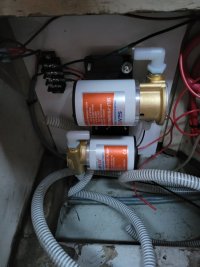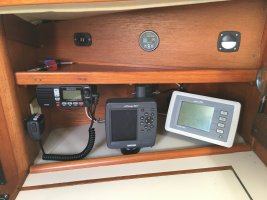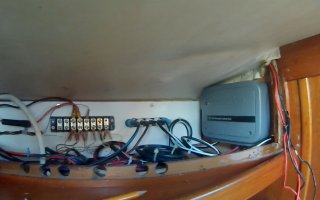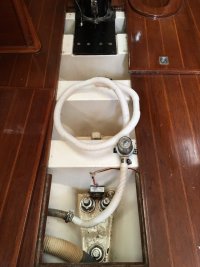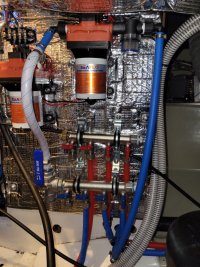This is probably a good time to follow up on where I'm at now. I think I've mentioned it on a few other posts, but this is a good post to get everything together. Long story short, I'm not done yet, so this is a combination of what's been done so far and what I'm planning on doing.
Battery:
Engine start is a group 24 AGM located in the outside compartment of the port lazaratte.
House is a custom built LiFEPO4 280 ah in a Sun Fun Solar Kits battery box located just forward of the engine start battery
I'm really liking this configuration. It has moved the rarely accessed batteries to a compartment that's difficult to access and opened up the more easily accessed compartment where they used to be for items like tools, wiring, and bilge pumps. I sold the idea to my wife by saying it would provide more accessible storage, she's not entirely happy I used it for tools.
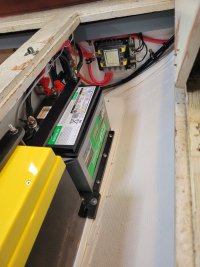
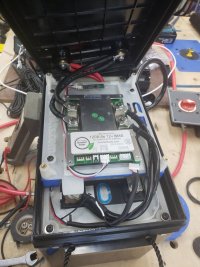
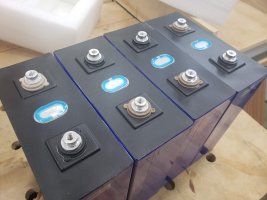
Charger:
ProNautic 1220p (I think I incorrectly stated I had a 1230 or 1240 on other posts. I recently verified it is the 20 amp version). This is located behind the nav desk drawers. My drawers were falling apart, so I pulled them out to rebuild and noticed the space available for the charger. This will require shortening the drawers by a few inches and installing rails mounted to the outside of the cabinet instead of the back. The charger was previously mounted where your legs would go when you're sitting at the nav desk. I thought it would be out of the way, but I hit my knee on it one too many times.
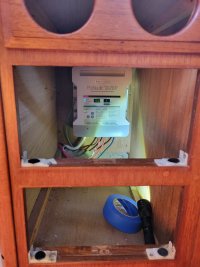
The charger is mounted, but the drawers are not done yet. Once they are installed, I'll add a remote panel to the charger which will allow me to easily change settings and view the charger operation.
Inverter:
Renogy 1000W located upside down on the bottom of the nav desk chart table. This is the area where the two map tubes are located. my tubes were cracked, so I removed them and came to the conclusion that I don't use paper charts very often. I'm planning on putting a decorative grate behind the two holes to provide ventilation and clean it up a bit. I haven't completed this install yet.
The inverter will be used for small loads like laptops, tool battery charger, TV (to keep the kids and their friends happy), and maybe small kitchen appliances. I am limited on inverter size by the house battery BMS (120amp).
The inverter will be wired to the main cabin 120v outlets through a breaker panel with two dual pole 15 amp breakers using an interlock devise. this will allow switching between shore power and inverter power while ensure both are not connected at the same time. I'm planning on installing additional outlets wired only to the shore power panel to run tools, heaters, and anything else we wouldn't want to accidently run through the inverter. I've mocked it up and tested on my work bench, but haven't installed on the boat yet (it involves reconfiguring my electrical panel and some cabinetry work)

DC to DC charger:
Renogy DCC40s (the new model is a 50 amp version) - located on the forward bulkhead of the compartment where the battery chargers are located. This has been critical in the LiFEPO4 battery install by allowing me to send all of my charging sources through the AGM battery and have a single source charging the house lithium battery. It also provides protection against BMS charge cut offs affecting the alternator or battery charger.
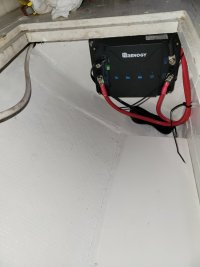
Battery switch:
Blue Sea Systems 8280 battery switch panel with combiner. Located on the aft bulkhead inboard of the nav desk at the base of the stairs. This provides short wire runs, easy access, and the ability to independently switch the house and engine batteries while maintaining an emergency battery combine function. I really like this configuration. It allows me to leave the house battery on, charge both batteries, and have the piece of mind that my engine starter is not energized while the boat is in the slip.
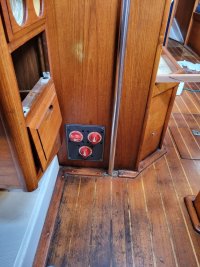
Fresh water pumps:
Seaflo variable speed dual pump - located behind the engine on the starboard side of teh engine compartment. In theory, these should work in unison. When the flow requirement is low, one pump should spin slowly. As the demand increases, the first pump should speed up to full speed, then the second pump should kick in. I plumed these incorrectly and have been slowly working on correcting it. I currently only have one pump plumbed in, but it's function very well with no pulsing and sufficient flow. All the pumps in the boat are seaflo and I've only had one DOA so far. They probably aren't as good as some other brands, but they are so much less than their competitors, you can tolerate some failure.
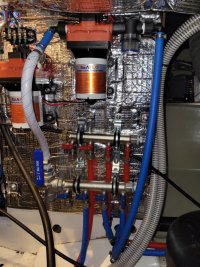
Bilge Pumps:
Seaflow flexible vane pumps for both shower and main bilge - located in the aft compartment of the port side lazzarette where the batteries used to be. So far, this is a great set up and my bilge is considerably dryer only leaving a small puddle that is easily cleaned up with a sponge.
